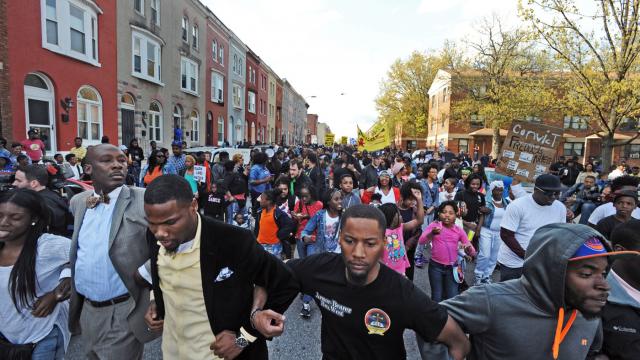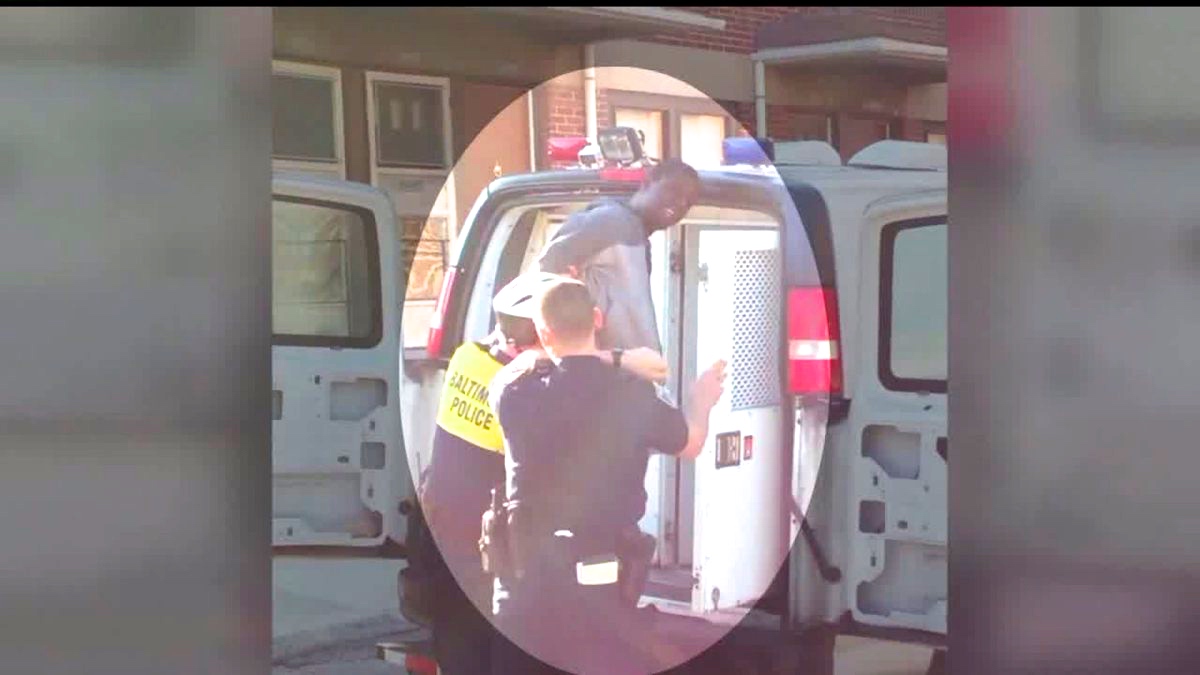
Protests over the police killing of 25-year-old Freddie Gray in Baltimore, Maryland continued on Wednesday and into Thursday, with hundreds demonstrating in front of the Western District police station where Gray was taken following his arrest on April 12. Hundreds of people also marched to nearby City Hall, where thousands were expected to protest Thursday evening. Demonstrations are also planned for Saturday.
Of the more than 350 police killings that have taken place in the US so far this year, the murder of Freddie Gray is among the most horrific. Before his encounter with Baltimore police, Gray was perfectly healthy. Within an hour of making eye contact with an officer, he was in a coma, three fractured cervical vertebrae in his neck having severed 80 percent of his spinal cord. He died on Sunday, prompting an outpouring of protest.
On Wednesday, Michael Davey, a lawyer representing the Baltimore Fraternal Order of Police, unequivocally defended the officers’ actions at a press conference, declaring that none of the cops had committed a crime. Gene Ryan, president of the Fraternal Order of Police lodge, described the protesters as a “lynch mob” and assured the police that “the union is 100 percent, completely behind the officers.”
Another police union official told the assembled reporters that those in the precinct who were hostile to the police were the “criminal elements.”
Since Gray slipped into a coma, police officials have insisted that the officers used no force whatsoever and the victim’s injuries were sustained as a result of an unspecified event in the police van that transported Gray to the Western District station house. Despite at least two videos that show Gray being brutally dragged, screaming in pain, to the police van, Davey again declared Wednesday, “Our position is something happened in that van, we just don’t know what.”
On Tuesday, a friend of Gray who witnessed his arrest told CNN anonymously that he watched officers contort Gray into “a pretzel type of move, where they had the heels of his feet to his back, and he was still in handcuffs.” On Wednesday, the same witness claimed that by the time he began filming the arrest, one officer “had their knee in [Gray’s] neck. He was like crushing his neck really hard.”
Police claim Gray was carrying a switchblade, a contention discounted by Gray’s friend. “I’ve never known Freddie to carry any type of weapon,” he said, adding,
“I don’t believe for one second that he would be aggressive toward the police in any type of way, because we know that police brutality is prevalent in our neighborhood.”
Another witness and protester, Harold Perry, told CNN that he heard Gray cry out, “Get off my neck! Get off my neck! You’re hurting my neck!”
In widely viewed bystander footage, Gray can be heard screaming repeatedly as officers drag him to the back of a police van, prompting one witness to shout, “His legs are broken!” While the footage indicates that Gray had lost the use of his legs, the six officers who participated in the arrest did not request an ambulance and instead drove Gray across the city for the some thirty minutes, stopping to arrest one other man.
On Wednesday, a new cell phone video emerged showing officers putting ankle cuffs onto a motionless Gray minutes after his initial arrest a few blocks away. Witness Jacqueline Jackson told CNN that when police applied the ankle cuffs, “He wasn’t responding. His head was down.” After the ankle cuffs were secured, “They picked him up and threw him up in the paddy wagon.”
When asked by CNN’s Miguel Marquez whether Gray appeared to be unconscious, Jackson replied, “Yes. Yes, and I asked them, ‘Could they get him a paramedic?’ They told me to ‘mind my business.’ And I said, ‘It is my business!’”
From the start, the police and political establishment have sought to cover up the obvious responsibility of the police for Gray’s death. On Wednesday, Deputy Commissioner David Rodriguez said, “None of the officers describe using any force against Mr. Gray.”
The lawyer for Gray’s family, William Murphy, told CNN, “We have no confidence that the police can investigate their own. We have no confidence that the police can do this free of conflicts of interest.”
Baltimore has been ravaged by years of deindustrialization and nearly a quarter of its residents fall below the poverty line. Last month, Baltimore residents protested the city authorities’ decision to begin shutting off water service to residents who are behind on their water bills. The city’s Department of Public Works announced that it would begin shutting off water to as many as 25,000 poor residents.
Since 2011, Baltimore has paid $5,765,065 in settlements and court judgments for cases alleging officer misconduct, including the slamming of a pregnant woman into the ground, the killing of an unarmed veteran, and the beating of a church deacon. Gray’s death is the sixth killing by Baltimore police since the start of 2015.
It is the latest in a wave of police killings over the past month, including:
The April 15 shooting of unarmed Frank Shephard by Houston police, who fired up to a dozen bullets into their victim following a car chase.
The April 4 murder of 50-year-old Walter Scott, shot multiple times in the back by a South Carolina police officer. The cop was charged with murder following the release of a bystander video showing the officer shooting the fleeing, unarmed Scott and then planting a Taser next to his motionless body.
The shooting of 17-year-old Justus Howell the same day in Zion, Illinois, prompting protests by hundreds of people. The cop shot the youth in the back.
The April 2 shooting of 44-year-old Eric Harris of Tulsa, Oklahoma by a police deputy, who subsequently claimed the shooting was an accident. A video shows Harris saying he cannot breathe, to which an officer replies, “F*ck your breath” as he jams his knee into Harris’s back.
On Monday, White House press secretary Josh Earnest said the rash of police killings making national headlines did not point to an increase in police violence. He declared, “I don’t think that anybody is in a position to suggest that these incidents that are getting national attention necessarily represent a spike in more violent police activity.” It was, rather, a question of greater public awareness of violent incidents.
While Earnest was callously seeking to downplay the epidemic of police killings, it is difficult to say which scenario is more damning: a growing wave of police killings or a situation where daily police murders were long the norm in America but were covered up by the government and the media.
In any event, the Obama administration has made it a policy not to keep an official record of police killings nationwide. (Other sources put the toll of police killings last year at more than 1,100). At the same time, the administration has transferred billions of dollars in military hardware to local police departments.
In poor and working-class communities throughout the country, police function as paramilitary death squads, killing and torturing with impunity, knowing they will be protected by the government on the local, state and federal level.
3 WAYS TO SHOW YOUR SUPPORT
- Log in to post comments













